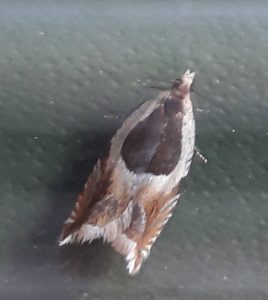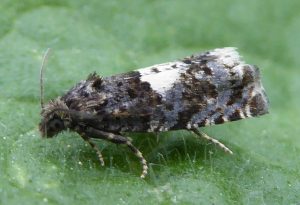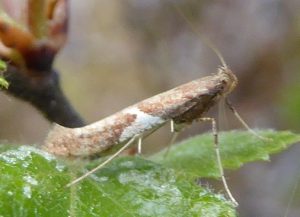
I’ve had a busy time over the last couple of months, and not a lot of time spent in the office- so I for one am appreciating all the dry sunny weather!
At the start of May I attended a recording workshop run by my Butterfly Conservation colleague Anthony McCluskey at Pitencrief Park in Dunfermline. After a morning session covering ID tips and recording techniques, we headed out to look for some live examples- unfortunately the butterflies were nowhere to be seen, so we made do looking at some obliging bumble bees instead! Luckily, since then, the sunny weather has enticed out the butterflies and I counted 12 Large Heath while walking a transect at Wester Moss. Large heath are restricted to wet boggy sites as their main larval food-plant is Hare’s-tail Cottongrass (Eriophorum vaginatum) which is only found on bogs. On the same day I spotted my first ever Common Blues. The caterpillars of these small bright blue butterflies feed on members of the pea family, especially Common Birds-foot-trefoil (Lotus corniculatus) and are a joy to behold flying in the sunshine! They can be spotted from May to September and if you spot one this year Butterfly Conservation would like to hear about it: Have you seen a Common Blue?.
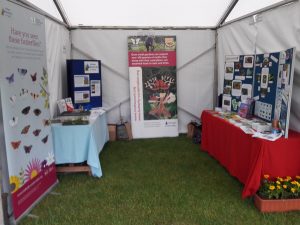
I’ve also been out and about attending a variety of events, one of which was Gardening Scotland, where I helped out on Butterfly Conservation’s stand talking to visitors about ways to make their gardens more welcoming for Lepidoptera. It was great to hear how keen most gardeners are to include areas of wild or native plants to help support their local butterflies and moths.
I was also really pleased to be asked along to deliver a workshop on Insect ID as part of the Scottish Wildlife Trust’s training day for their Wildlife Watch groups volunteer leaders. I ran 3 short outdoor sessions introducing some ideas and techniques for ‘Bug hunting’ with their groups. Two of the participants even managed to find micro-moths while  having a go at sweep-netting in the long vegetation! Two lovely little Glyphipterix simpliciella, which are tiny but beautiful metallic moths which can often been spotted in large numbers on the open flowers of buttercups. I mentioned this species in my last blog as the caterpillar feeding signs are easy to spot on the stems of Cocks-foot grass.
having a go at sweep-netting in the long vegetation! Two lovely little Glyphipterix simpliciella, which are tiny but beautiful metallic moths which can often been spotted in large numbers on the open flowers of buttercups. I mentioned this species in my last blog as the caterpillar feeding signs are easy to spot on the stems of Cocks-foot grass.
As well as getting involved with external events I’ve also attended a couple of training courses to help improve my own knowledge of the habitats I’m working on. Back in May I headed down to FSC Preston Montford, where I caught up with fellow trainee Holly, before spending 3 days learning all about how to carry out Phase 1 vegetation surveys, which are used to map out the main habitats found on a particular site. I followed this up with a trip to FSC Kindrogen in Perthshire last weekend for a course on how to recognise the different National Vegetation Classification (NVC) communities found on Heaths and Mires. I had also been intending to spend a few days out at Wester Moss completing a vegetation survey, along with a student who spent a 3 week placement at BC. However, after spending a day with my mentor David, showing us the outline of the survey, we decided to delay it as identifying crispy Spagnum mosses turned out to be very tricky… we’ll get back to that when the rains return!
Talking of rain, Loch Lomond has become a familiar site over the last few weeks, where I attended the Scottish Entomologist’s Gathering held near Rowardennan, spending a weekend out in the gorgeous oak woodlands with light traps and nets looking for interesting moth species. Although we had some lovely finds, it has to be said that the most abundant insects that weekend were definitely the good old Midge! Then a couple of days later I joined my fellow Natural Talent Trainees for a camping trip to the lovely little island of Inchcailloch. It was a great chance to catch up and share tips and examples from each of our projects.
Back on the mothy front and I’m still heading out to look for new species whenever I can, and now there are plenty of adults on the wing to keep me busy with the ID books. Here are just a few examples of the variety to be found:
And last but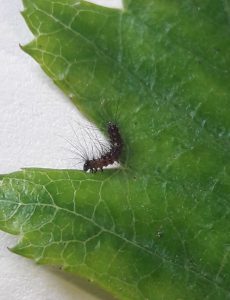 not least some of the larvae I collected earlier in the year have successfully pupated and have begun to emerge! These include eggs of the Vapourer Moth, which hatched out 3 tiny but stunning little caterpillars. These guys eat the leaves from broadleaf trees and won’t be tiny for long…
not least some of the larvae I collected earlier in the year have successfully pupated and have begun to emerge! These include eggs of the Vapourer Moth, which hatched out 3 tiny but stunning little caterpillars. These guys eat the leaves from broadleaf trees and won’t be tiny for long…
Watch this space, or you can catch me on Twitter too: @catofthewoods.
Thanks as always to TCV and Esmee Fairburn Foundation for this fantastic opportunity and to Butterfly Conservation for having me!

